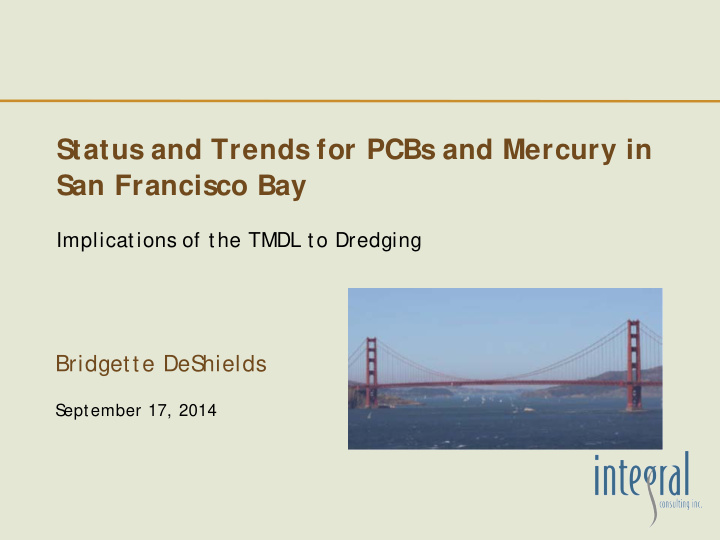



Status and Trends for PCBs and Mercury in San Francisco Bay Implicat ions of t he TMDL t o Dredging Bridgette DeS hields S eptember 17, 2014
Topics • Background — History of RMP sediment monitoring — TMDLs and dredging • TMDL and DMMO thresholds • Changes in monitoring program
Regional Monitoring Program (RMP) • S tarted in 1993 as a collaborative effort between regulators and regulated community • Collect water, sediment, and tissue samples from S an Francisco Bay and its tributaries • Provides water quality regulators and managers with information they need to manage the estuary effectively • Oversight by steering committee and technical review committee
RMP S ediment Monitoring Original Design: Fixed Stations Redesign: Fixed & Random Stations
Dredging and TMDLs • Dredging results in an overall net loss of PCBs and Hg from the Bay • No load is allocated • S ediments disposed of in Bay should have PCB & Hg concentrations no greater than that in ambient surface sediments in the Bay. —not to exceed the 99th percentile of total PCB and Hg concentrations of the previous 10 years of Bay surface sediment samples collected through the RMP
http://www.sfei.org/content/dmmo- ambient-sediment-conditions
Current Thresholds
Trends in TMDL/ DMMO Limits Hg PCB 0.5 35 UTL of 99th Percentile (mg/kg) UTL of 99th Percentile (ug/kg) 0.49 30 0.48 25 0.47 0.46 20 0.45 15 0.44 0.43 10 0.42 5 90% 90% 0.41 0.4 0 2011 2012 2013 2014 2011 2012 2013 2014 PAH 5000 • 34% increase for PCBs and UTL of 90th Percentile 6% decrease for PAHs from 4800 2011 to 2014 (ug/kg) 4600 • Hg concentrations stable 4400 4200 90% 4000 2011 2012 2013 2014
Change in S ampling Frequency 27 stations for sediment, 2014 - 2023
S ummary • Thresholds vary each year —Material acceptable one year may be unacceptable the next due to changes in 10-year averages —PCBs currently increasing, but management actions are intended to lower concentrations over time —Future TMDLs (S e, PAHs) • Change in testing frequency —Effect is unknown —Fewer data points; introduces some uncertainty • S hould testing frequency be reconsidered? • S hould averaging period be reconsidered?
Recommend
More recommend